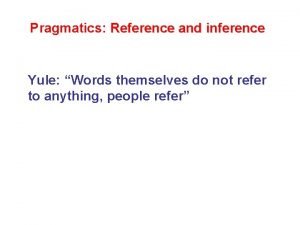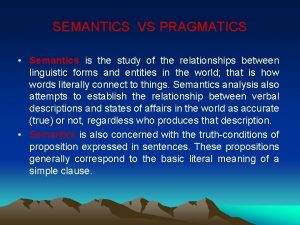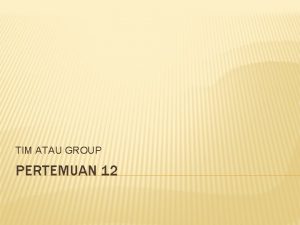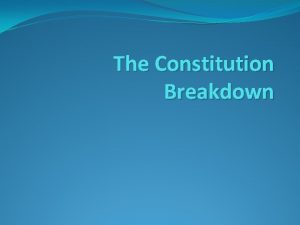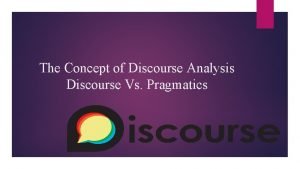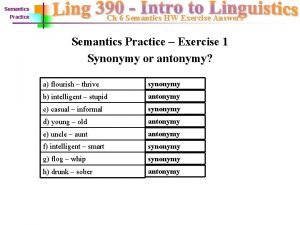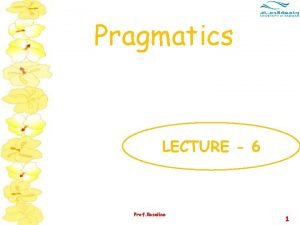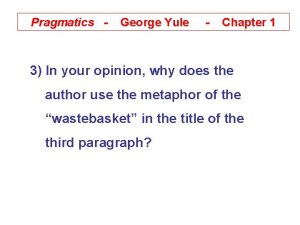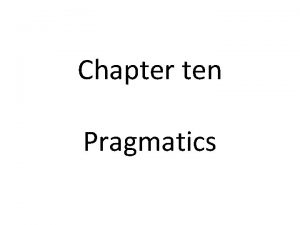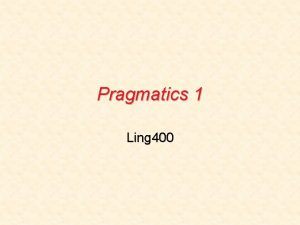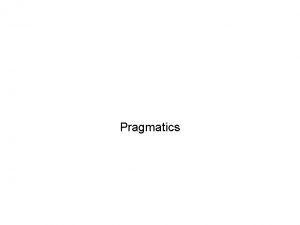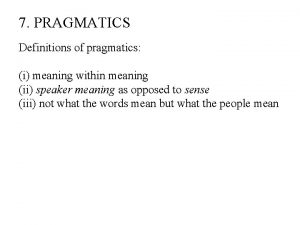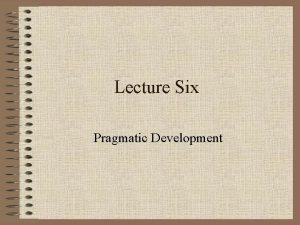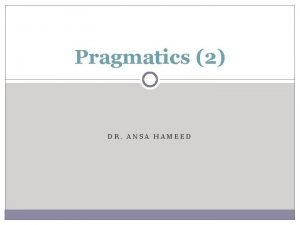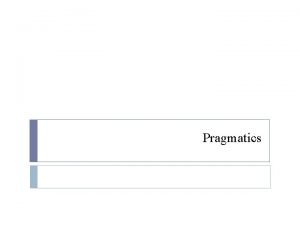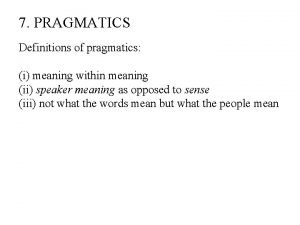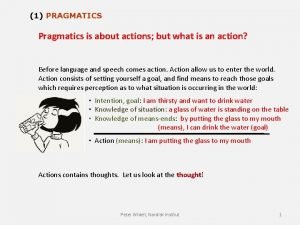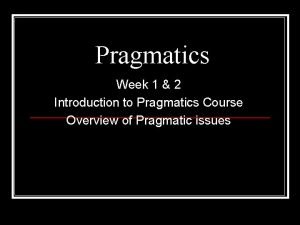MEETING 9 PRAGMATICS Definition of pragmatics In pragmatics















- Slides: 15

MEETING 9 PRAGMATICS

Definition of pragmatics In pragmatics we try to understand what speakers mean by their utterances. 1. Pragmatic sis the study of the speaker meaning e. g: I haven’t got the breakfast this morning. 2. Pragmatics is the study of ‘invisible’ meaning, or how we recognize what is meant even when it isn’t actually said or written. The hearer understands what is unsaid by the speaker. e. g: speaker : gimana kemaren? Hearer : oh, puas banget The speaker and hearer have the same background knowledge. According to Jenny Thomas, the definition of pragmatic which better than other is the study of meaning in interaction. Making meaning is a dynamic process, involving the negotiation of meaning between speaker & hearer, the context of utterance (physical, social, linguistic) and the meaning potential of an utterance.

Speech act • Allan (in Mey, 1998) states that speech act is created when speaker (S) makes an utterance (U) to hearer (H) in certain context (C) with the reflexive intention that H should recognize his/her message in the statement, request, promise, apology, command, etc. • Labov and Fanshel (1977: 30) say that ‘speech acts are a part of social interactive behaviour and must be interpreted as an aspect of social interaction’. • Marmaridou (2000: 167) mentions that speech acts are ‘acts which are performed through speech’. • It implicates that there are linguistic expressions that are being used for specific purpose and under certain extra-linguistic circumstances.

Classification of speech act by Searl 1. Assertive (representative): represent a state of affairs which expressed proposition characterized as being T/F by the speaker. e. g. assert, state, claim, describe (S believe X) 2. Commisive: commit the speaker to act and it necessary involve intention. e. g. promise, offers, pledge (speaker intends x) 3. Expressive: indicate the speaker’s psychological state in the sincerity condition of the proporsitional content. e. g. greet, welcome, thank, apologize (of feeling) (s feels x) 4. Directives: all attempts by speaker to get the hearer to do something e. g. command, request, invite (S want X) 5. Declaration: Acts which in their uttering the words and includes many of those which first considered as performative.

Speech act: first proposed by J. L Austin in this book “how to do things with words” 1. Performative: doing something by saying something 2. Constative : saying something that can be asses as true or false. Example: 1. I promise I will come on time (“saya berjanji saya akan datang tepat waktu”) 2. I apologize for coming late (“saya minta maaf karena datang terlambat”) 3. I name this ship Elizabeth (“ saya menamakan kapal ini Elizabeth”)

The performatives must meet a typology of conditions if they are to succeed or be ‘happy’. Those condition are known as the felicity condition Austin (1962) 1. The persons and circumstances must be appropriate (“pelaku dan situasi harus sesuai”) E. g : I pronunce you man and wife saya menyatakan saudara sebagai suami istri Ujaran di atas hanya dapat dipenuhi bila yang mengucapkan adalah seorang pastur atau pendeta. 2. The act must be executted completely and correctly by all participants (“tindakan harus dilaksanakan dengan lengkap dan benar oleh pelaku”) E. g : you are totally wrong Anda betul-betul salah 3. The participants must have the appropriate intentions (“pelaku harus mempunyai maksud yang sesuai”) E. g : I’ll see you in the office at three

Dasar-dasar pemikiran Austin: 1. Telecom Package: pesan sebelum disampaikan dibungkus agar tidak pahit. e. g. Bodoh banget lo !!! sepertinya anda agak lambat dalam berpikir. 2. Citrun juice : ketika bertutur apakah tuturan tersebut akan menyakiti orang lain atau justru mempermalukan diri sendiri. Maka dibungkus menggunakan lokusi, ilokusi, dan perlokusi. • 1. 2. 3. Austin further claims that in issuing an utterance, a speaker performs three acts (force) simultaneously: Locutionary act Illocutionary act Perlocutionary act

Felicity condition 1) Propositional is the condition that the words uttered say certain things about the world which is understood by the participant. e. g. mengucapkan turut berduka cita 2) Preparatory is the condition on the immediate context within which the speech act takes place e. g. krn tau dan kenal dia/keluarganya 3) Sincerity is the condition on the speaker’s belief desires and intentions 4) Essential are the rules of the game e. g.

LOCUTION, ILOCUTION, AND PERLOCUTION having demonstrated that in fact all utterances are performative, Austin reconsiders the senses in which ‘to say something may be to do something’ and concludes that in ‘issuing an utterance’ a speaker can perform three acts simultaneously: 1. A locutionary act : the act of saying something in the full sense of say E. g : it’s hot here 2. An illocutionary : an act performed in saying something (the act identified by the explicit performative) E. g : speaker asks hearer to open the window 3. A perlocution : the act performed by or as a result of saying E. g : the hearer opens the door

According to Grice: v He proposed that to have a success communication in conversation between (speaker and hearer) must obey a set of principle which includes for conversational rule. v Cooperative principle make your conversation contribution such as is required at the stage at which it occurs by the accepted purpose or direction of the talk exchange in which you are engage. v Maxims: aturan-aturan yang bersifat normative, sanksi bersifat sosial, yang mengatur bagaimana speaker&hearer bekerja sama. There are 4 maxims: 1) Quantity : make your contribution as informative as is required don’t than is required. e. g. : why you’re late? because it’s rain 2) Quality : try to make your contribution one that is true. Don’t say what you believe to be false. e. g. : menyuruh anak berbohong saat sendirian di rumah.

3) Relation e. g. : be relevant : B: sus, tolong surat ini diketik dan difax ke Mr. x K: kasihan ibu itu sudah lama nunggu both of them are relevant in context. 4) Manner : avoid obsecurity (ujaran samar) Be brief (singkat) avoid ambiguity (ujaran ganda) Be orderly (runtut) you must speak in sincerity, clearly, and relevantly. v Dengan adanya muka yang terancam, timbul 2 cara penyampaian: 1) Eksplikatur: ungkapan yang patuh pada PKS (Prinsip Kerja Sama), biasanya ungkapan yang baik-baik dan tidak mengancam muka petutur. 2) Implikatur: ungkapan ini terjadi karena ada pelanggaran maxim/bidal.

IMPLICATURE According to Grice, implicature is additional conveyed meaning which is inferred indirectly or through the hints and understood implicitly. People don’t actually speak following the maxims the whole time sometimes to fulfill their intension in a conversation people deliberation violet (melanggar maxims) IMPLICATURE (what you say is not what you mean) Effect dari sebuah ujaran, makna dari sebuah ujaran

THE EXAMPLE OF IMPLICATURE e. g. dalam lawak Jojon : aku gak suka ma tukul, seperti ikan lele kan? Gogon : (dibelakang jojon da tukul) aduh aku laper nih, makan yuk Gogon tidak menjawab apa yang ditanyakan Jojon, Gogon telah melanggar maxim, tapi dibalik pelanggaran tersebut ada tujuan tertentu yaitu untuk menunjukan pada Jojon bahwa yang sedang dibicarakan (T) ada di belakang. e. g. A: Where’s my box of chocolate? B : Your brother was in your room last night I was very hungry at that time. v Dalil Pragmatik: dalam setiap ujaran/tuturan ada maksud yang ingin disampaikan. Apa maksud dari penutur dan petutur, memungkinkan adanya potensi muka terancam.

PRESUPPOSITION Presupposition is something the speaker assumes to be the case prior to make an utterances. e. g. Mary’s brother bought three horses (yang harus ada di benak speaker) 1. Mary exist and has one brother 2. He has a lot of money entail: Mary’s brother bought something. q Types of presupposition 1) Existential presupposition: (benar 2 ada dan terjadi) e. g. the girl is next door benar 2 ada perempuan di balik pintu 2) Lexical presupposition: (karena lexical tertentu) e. g. he try to pass the test He try he didn’t try to pass the test you’re late again (you were late before)

3) Structural presupposition: (it doesn’t need to check) e. g. when did he leave? He left 4) Factive presupposition: (ada fakta) e. g. we regret telling him told him we don’t regret telling him I’m glad that it’s over I’m not glad that it’s over 5) Non-factive presupposition (it doesn’t need to check) e. g. I dreamed that I was rich I wasn’t rich 6) Counter factual presupposition (it doesn’t need to check) e. g. If I were your friend I’m not your friend
 For today's meeting
For today's meeting Today meeting or today's meeting
Today meeting or today's meeting What is meeting and types of meeting
What is meeting and types of meeting Types of meeting
Types of meeting Example of reference and inference
Example of reference and inference Locution illocution perlocution examples
Locution illocution perlocution examples Semantic vs pragmatic
Semantic vs pragmatic Team building meeting definition
Team building meeting definition Annapolis convention definition
Annapolis convention definition Pragmatic analysis
Pragmatic analysis Answer
Answer What is pragmatics in linguistics
What is pragmatics in linguistics Invisible meaning in linguistics
Invisible meaning in linguistics The performative hypothesis
The performative hypothesis Temporal dexis
Temporal dexis Pragmatic wastebasket
Pragmatic wastebasket




